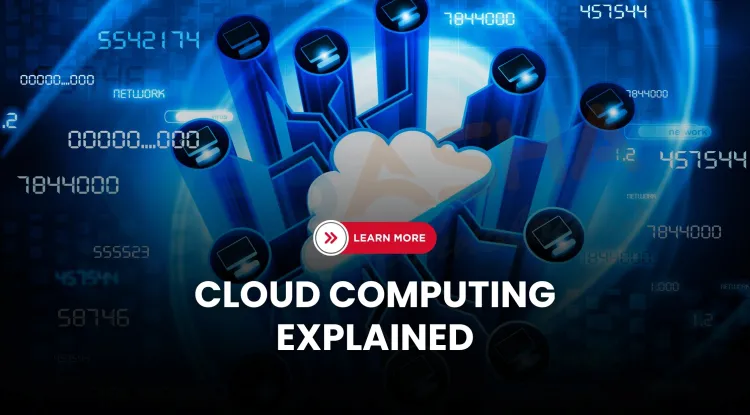Cloud computing is transforming how we store, process, and access data, powering everything from apps on your phone to global businesses. In 2025, it’s more accessible than ever, even for those new to tech. This guide breaks down what cloud computing is, how it works, its benefits, and why it matters, all in plain language for beginners.
What Is Cloud Computing?
Cloud computing is like renting powerful computers over the internet instead of owning them. Imagine not needing a physical PC in your room—instead, you use someone else’s supercomputer stored in a data center far away, accessing it through your device via the internet. These “cloud” services let you store files, run apps, or analyze data without buying expensive hardware.
In 2025, cloud computing drives over 60% of global internet traffic, from streaming Netflix to hosting AI tools like ChatGPT or Apple Intelligence. It’s the backbone of modern tech, making services fast, scalable, and affordable.
How Does Cloud Computing Work?
Cloud computing relies on data centers—massive warehouses filled with servers (powerful computers) connected to the internet. These servers handle three main tasks:
- Storage: Saving your photos, videos, or business data (e.g., Google Drive, iCloud).
- Processing: Running apps or crunching numbers (e.g., Zoom calls, AI image generation).
- Networking: Connecting users to services instantly, anywhere (e.g., TikTok’s global reach).
When you use a cloud service, your device sends requests to these servers. The servers do the heavy lifting and send results back. For example, when you upload a photo to Dropbox, it’s stored on their servers, not your phone, freeing up space.
Key Components
- Servers: The physical machines in data centers.
- Virtualization: Software that splits one server into many “virtual” ones for efficiency.
- Cloud Platforms: Providers like Amazon Web Services (AWS), Microsoft Azure, and Google Cloud, which manage the infrastructure.
- Internet: The highway connecting you to the cloud.
Types of Cloud Computing
There are three main types of cloud services, each serving different needs:
- Infrastructure as a Service (IaaS): Rent raw computing power, like servers or storage (e.g., AWS EC2 for startups building apps).
- Platform as a Service (PaaS): Tools for developers to create apps without managing servers (e.g., Google App Engine for building websites).
- Software as a Service (SaaS): Ready-to-use apps you access online (e.g., Gmail, Netflix, or Canva).
Additionally, clouds can be:
- Public: Shared by many users (e.g., AWS, affordable for all).
- Private: Dedicated to one organization for security (e.g., banks).
- Hybrid: A mix of both for flexibility.
Benefits of Cloud Computing in 2025
Cloud computing has reshaped how we work and live. Here’s why it’s a game-changer:
- Cost Savings: No need to buy expensive hardware. Pay only for what you use (e.g., $0.10/hour for a basic AWS server).
- Scalability: Instantly add power for big tasks, like Black Friday sales for online stores.
- Accessibility: Access files or apps from any device, anywhere (e.g., edit a Google Doc from your phone or laptop).
- Innovation: Powers AI, gaming, and AR/VR (e.g., cloud gaming like Xbox Cloud Gaming runs on Azure).
- Sustainability: Data centers optimize energy—AWS aims for 100% renewable energy by 2025.
Real-World Examples for Beginners
- Personal Use: Storing photos on iCloud, streaming Spotify, or collaborating on Google Docs.
- Small Businesses: Using Shopify for e-commerce or QuickBooks Online for accounting.
- Big Companies: Netflix streams globally via AWS; Zoom handles millions of calls on cloud servers.
- Gaming: Cloud platforms like NVIDIA GeForce Now let you play high-end games on low-end devices.
- AI: Apple Intelligence (on iOS 18.2) uses cloud servers for complex tasks like image generation.
Challenges to Understand
- Cost Overruns: Easy to overspend if you don’t monitor usage (e.g., leaving cloud servers running).
- Security: Data breaches are a risk, though providers like Azure use top-tier encryption.
- Internet Dependency: No Wi-Fi, no cloud access—rural areas can struggle.
- Learning Curve: Beginners may find setup complex (e.g., configuring AWS takes tutorials).
Why It Matters in 2025
Cloud computing powers the digital world. For individuals, it means instant access to tools like Zoom or Canva. For businesses, it’s a lifeline—94% of enterprises use cloud services, per a 2025 Flexera report. It fuels AI growth (e.g., Google’s Gemini runs on cloud infrastructure) and supports hybrid work, with 70% of U.S. workers using cloud-based collaboration tools.
Economically, the cloud market hit $680 billion in 2024, projected to reach $1 trillion by 2028, creating 500,000+ U.S. jobs. For everyday users, it keeps costs low—think $5/month for 100GB of Google Drive storage.
Getting Started as a Beginner
- Try Free Services: Google Drive (15GB free), Dropbox, or iCloud for storage.
- Explore Tutorials: AWS’s free tier or Microsoft Learn offer beginner guides.
- Use SaaS Apps: Start with familiar tools like Microsoft 365 or Slack.
- Learn Basics: Watch YouTube intros on cloud terms like “IaaS” or “virtual machines.”
Conclusion
Cloud computing in 2025 is like electricity—you don’t see it, but it powers your life. From streaming to AI, it’s affordable, flexible, and everywhere. Start small with free tools, and you’ll see why it’s the backbone of the digital age.
